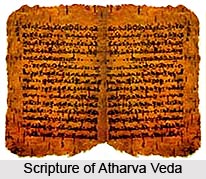 The Khandas of Atharva Veda consists of philosophical questions like about nature of the universe and the ecosystem. It also speaks on magic and incantations that can be used against opponents during rivalries. It is considered as the oldest text that deals with medicine and has its own germ theory. It also deals with the rites performed by royalty from birth till coronation. It has hymns that describe a house holder`s life and the rites that are performed in a house hold.
The Khandas of Atharva Veda consists of philosophical questions like about nature of the universe and the ecosystem. It also speaks on magic and incantations that can be used against opponents during rivalries. It is considered as the oldest text that deals with medicine and has its own germ theory. It also deals with the rites performed by royalty from birth till coronation. It has hymns that describe a house holder`s life and the rites that are performed in a house hold.
Magic in Atharva Veda
Atharva Veda consists of mantras for white and black magic. Problems like rivalries between women in relationship with the same man, rivalries between two men, attracting a man by a woman or a woman by a man have been dealt with. It also suggests incantations that can be used in such cases.
Medicine in Atharva Veda
Several diseases have also been dealt, disease causing agents and the cure for these diseases. The cure includes herbal medicines, drugs used along with the specific mantras. The medicine system that has been mentioned in Atharva Veda is older than that found in Ayurveda. This medicine system is based on the theory of external disease causing agents. It also discusses in brief about the internal body mechanisms that works against diseases. Ayur Veda is developed on top of the Atharva Vedic system of medicine.
Atharva Veda is the first Indic text that deals with medicine. The causes of disease had been identified that includes causative agents like the yatudhana, the kimidin, the krimi or and the durnama. It has been mentioned that they should be killed with a variety of incantations or plant based drugs. This approach to disease is different. Atharva Veda may be one of the earliest texts that record the uses of antibiotic agents.
Warfare in Atharva Veda
Some of the medicine practitioners of Atharva Vedic medicine became experts in making poisons that were used in war. There was a prevalent practice of applying snake poisons and poisons derived from some plants on arrows which are used in battles. Such arrows were called Nagastras or poisonous arrows. An accomplished archer did include such arrows in his collection. References to military practices that are associated with Kshatriya rites gave Atharva Veda its reputation.
Shamanism in Atharva Veda
Many of the hymns in Atharva Veda contain invocations that would cure diseases. It also contains magical incantations that are believed to defend one against evils done by enemies or to attack evil-doers. This indicates that a religion and philosophy which has its parallels in the Shamanic traditions. Atharva Veda is the oldest text that describes these practices. Similar traditions are found in the southern India as well as in various parts of central and eastern India.
Aryan Rituals in Atharva Veda
Regular and special rituals of the Aryans have been the major concern of Atharva Veda. Some of the major rituals covered are marriage and the funeral. Several hymns are specific to rituals of the bhrigu-angirasas, vratyas and Kshatriyas. Those who lived in a semi nomadic way adopted the Vratya rituals. There are also rituals that are aimed at the destruction of the enemies
Philosophy in Atharva Veda
In the hymns to Goddess Earth philosophical thought has been highly emphasized. The basis of Vaiseshika Darsana has been expressed in the mantra XII.1.26. Some of the hymns also contain pantheistic thought that describes the common thread running through all manifest and non-manifest existence. The theory of golden womb from which the Universe was formed has been mentioned. This theme has been repeatedly presented in various interpretations in later philosophies of Hinduism.













